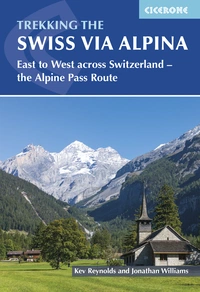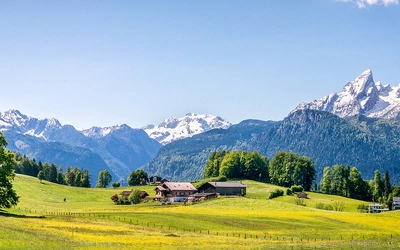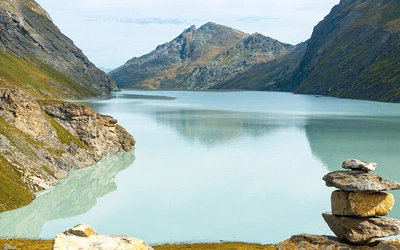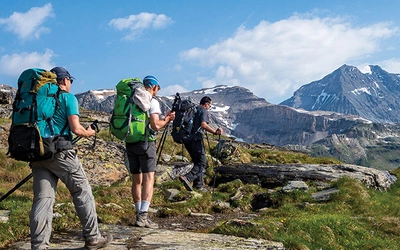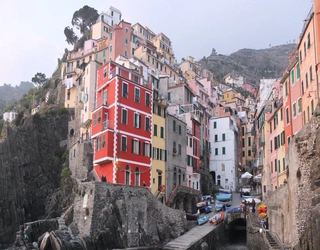Walking in the Engadine: a valley for all seasons
The Engadine Valley, with its blend of lakes, mountains, and traditional villages, offers unparalleled natural beauty and outdoor adventures. From high alpine trails to serene lakeside paths, the region promises a unique and memorable experience for nature lovers and hikers alike. Here, we highlight key locations and trails in the region, and author Kev Reynolds sings the region's praises.
Walking in the Engadine - Switzerland
Bernina, Engadine valley and Swiss National Park
£16.95
A guidebook to 100 day walks in the Engadine, Val Bregaglia, neighbouring valleys and the Engadine National Park. Varying from gentle rambles to adventurous high-level routes for the experienced mountain walker. The routes range from 4 to 16km long, visiting forests and meadows, high mountain landscapes, lakes and passes.
More informationEngadine Valley Highlights
Stretching nearly 100 km from Maloja to Martina in southeast Switzerland, the Engadine Valley features dramatic landscapes and picturesque villages. Key highlights include:
- Val Bregaglia: Steep-walled and Italian-flavored, guarded by Piz Badile and Cengalo.
- Val Bernina: Offering views of the snowy Bernina massif.
- Lakes and National Park: Four great lakes in the upper valley and Switzerland’s only national park in the Lower Engadine.
- Scenic Villages: Some of the most attractive and unspoilt villages in the Alps.
Notable Locations and Activities
- Soglio: Situated above Val Bregaglia with views over chestnut woods and Val Bondasca. Accessed by a specialized postbus.
- Alp Tombal and Plan Vest: Higher than Soglio, offering serene views and the sound of cowbells.
- Maloja Pass: Features the track to Lägh da Cavloc and routes into Italy or Val Forno.
- Piz Lunghin and Piz de la Margna: Walkers’ mountains providing extraordinary lookouts over Engadine’s peaks and lakes.
- Fuorcla Surlej: Offers stunning views of Piz Bernina from Val Roseg.
Key Walks and Trails
- Val Roseg: Descend to a charming hotel or take the scenic high route to the Coaz Hut.
- Pontresina: Access to high-level trails and routes towards Piz Kesch.
- Madulain to Es-cha Hut: Delightful walk leading to views of Piz Kesch.
- Val Funtauna and Kesch Hut: Sublime landscape and unspoilt beauty.
Swiss National Park
- Varusch Hut: A pleasant stroll from S-chanf to the park’s edge.
- Zernez Visitor Centre: Main access point to the park.
- Val S-charl: Accessed from Scuol, this area within the park is rich in wildlife and offers a unique opportunity to sleep at Blockhaus Cluozza.
The Lower Engadine
In the Lower Engadine, the Romansch language flourishes in village streets. It's spoken by about 1% of the Swiss population, but it's alive and thriving here. The region boasts a unique architectural style and Romansch-named villages. Though the landscape differs from the upper valley, it remains equally attractive with rewarding walks.
Val Tuoi and Guarda
- Val Tuoi: A gentle valley with flower-filled meadows at its entrance, rough pastures in the middle, and the striking Piz Buin at its head. The comfortable Tuoi Hut is located at the base of Piz Buin.
- Guarda: A picturesque village with old, thick-stone houses, petunia-bright windows, wrought iron grilles, and traditional Romansch sgraffito decorations. Cobblestone streets and stone troughs of pure, cold water add to its charm. It takes 2½ hours to walk from Guarda to the Tuoi Hut.
Romansch Villages
The Lower Engadine features several beautifully decorated Romansch villages. If inclement weather disrupts walking plans, exploring these villages is a delightful alternative, offering unique architecture and cultural insights.
A valley for all seasons
It was mid-winter when I first set eyes on the Engadine. A week before Christmas, snow lay deep and crisp and even, and metre-long icicles were suspended from every gutter. My train arrived in the late evening and outside the station the frost-laden air cut right through my inadequate sea-level clothing. At 1800 metres I’d never known cold like it. But a big moon hung in the sky and across the frozen lake mountains reached up to stars that sparkled like diamonds. By the time I’d reached the end of the lake and found the hostel where I’d be working for the rest of the winter, I knew I’d made the right decision. A conventional office career at home was not for me.
I skied at every opportunity that winter. Mostly downhill on battered, second-hand skis, but on days with more time to play with I’d make my own way into side valleys: Val Fex where one of my heroes, the guide Christian Klucker, lay buried; Val Roseg opposite Pontresina, a dazzling gem of a valley that became one of my all-time favourites; and the Morteratsch valley with Piz Palü, Bellavista, Piz Bernina and Roseg drawing me ever deeper into its snow-bound recesses.
Spring came, the snow melted and soldanellas filled meadows I’d only imagined before. But my contract ran out and I traded Switzerland for Austria. Until the following winter, that is. Then I returned to the Engadine to begin married life among mountains that had become my neighbours and friends. And there we’d stay as winter turned to spring once more, spring became summer and slid gently into golden autumn proving, if ever proof were needed, that the Engadine is a valley for all seasons.
Kev Reynolds
You'll find all the highlights mentioned above in our guide to Walking in the Engadine - Switzerland. There's something for every walker's taste: gentle valley rambles; craggy mid-mountain walks for the more adventurous; high-level routes that lead across glacier, snowfield and rugged passes for the experienced mountain trekker. Routes are graded and range from 4 to 16km long.
Walking in the Engadine - Switzerland
Bernina, Engadine valley and Swiss National Park
£16.95
A guidebook to 100 day walks in the Engadine, Val Bregaglia, neighbouring valleys and the Engadine National Park. Varying from gentle rambles to adventurous high-level routes for the experienced mountain walker. The routes range from 4 to 16km long, visiting forests and meadows, high mountain landscapes, lakes and passes.
More information





